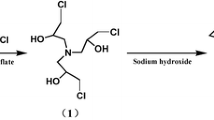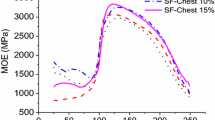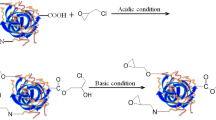Abstract
This investigation characterized wettability and adhesive properties of the major soy protein components conglycinin (7S) and glycinin (11S) after urea modification. Modified 7S and 11S soy proteins were evaluated for gluing strength with pine, walnut, and cherry plywood and for wettability using a bubble shape analyzer. The results showed that different adhesives had varying degrees of wettability on the wood specimens. The 7S soy protein modified with urea had better wettability on cherry and walnut. The 11S soy protein modified with 1M urea had better wettability on pine. The 1M urea modification gave 11S soy protein the greatest bonding strength in all the wood specimens. The 3M urea modification gave 7S soy protein stronger adhesion on cherry and walnut than did 11S protein; but with pine, 11S soy protein had greater adhesion strength than 7S soy protein. Measurement of protein secondary structures indicated that the β-sheet played an important role in the adhesion strength of 3M urea-modified soy protein in cherry and walnut, while random coil was the major factor reducing adhesion strength of 7S soy protein modified with 1M urea.


Similar content being viewed by others
References
Kalapathy U, Hettiarachchy NS, Myers D, Hanna MA (1995) Modification of soy proteins and their adhesive properties on woods. J Am Oil Chem Soc 72:507–510
Hettiarachchy NS, Kalapathy U, Myers D (1995) Alkali-modified soy protein with improved adhesive and hydrophobic properties. J Am Oil Chem Soc 72:1461–1464
Kalapathy U, Hettiarachchy NS, Myers D, Rhee KC (1996) Alkali-modified soy proteins: effect of salts and disulfide bond cleavage on adhesion and viscosity. J Am Oil Chem Soc 73:1063–1066
Sun SX, Bian K (1999) Shear strength and water resistance of modified soy protein adhesives. J Am Oil Chem Soc 76:977–980
Huang WN, Sun X (2000) Adhesive properties of soy proteins modified by urea and guanidine hydrochloride. J Am Oil Chem Soc 77:101–104
Huang WN, Sun X (2000) Adhesive properties of soy proteins modified by sodium dodecyl sulfate and sodium dodecylbenzene sulfonate. J Am Oil Chem Soc 77:705–708
Zhong ZK, Sun X, Fang XH, Ratto JA (2001) Adhesion properties of soy protein with fiber cardboard. J Am Oil Chem Soc 78:37–41
Cheng EZ (Michael) (2004) Adhesion mechanism of soybean protein adhesives with cellulosic materials. Ph.D. Dissertation, Kansas State University, Manhattan, KS
Van der Leeden MC, Rutten AACM, Frens G (2000) How to develop globular proteins into adhesives. J Biotechnol 79:211–221
Wright DJ (1987) The seed globulins. In: Hudson BJF (ed) Developments in food proteins. Elsevier, London, pp 81–157
Thanh VH, Shibasaki K (1976) Major proteins of soybean seeds. A straightforward fractionation and their characterization. J Agric Food Chem 24:1117–1121
Wang MZ (1987) Adhesion of wood and metal. In: Wang MZ, Huang YC (eds) Adhesive application handbook, Chemical Industry Press, China, pp 374–407
Liu ZM (2002) Surface feature of wheat straw and adhesive joint mechanism of wheat straw particleboards. Ph.D. Dissertation, Northeast Forestry University, Harbin, Heilongjiang province
Hemingway RW (1969) Thermal instability of fats relative to surface wettabilty of yellow birch. Tappi J 52:2149–2155
Hse CY (1972) Wettability of southern pine veneer by phenol formaldehyde wood adhesives. For Prod J 12:452–461
Hse CY (1971) Properties of phenolic adhesives as related to bond quality in southern pine plywood. For Prod J 21:44–52
Kajita H (1992) Wettability of the surface of some American softwoods species. Mokuzai Gakk 38:516–521
Mo XQ, Sun X, Wang DH (2004) Thermal properties and adhesion strength of modified soybean storage proteins. J Am Oil Chem Soc 81:395–400
Zhang X, Huang LX, Nie SQ (2003) FTIR characteristic of the secondary structure of insulin encapsulated within liposome. J Chin Pharm Sci 12(1):11–14
Van de Weert M, Haris PI, Hennink WE, Crommelin DJA (2001) Fourier transform infrared spectrometric analysis of protein conformation: effect of sampling method and stress factors. Anal Biochem 297:160–169
Zhao XY, Chen FS, Xue WT, Lee LT (2007) FTIR spectra studies on the secondary structures of 7S and 11S globulins from soybean proteins using AOT reverse micellar extraction. Food Hydrocoll. doi:10.1016/j.foodhyd.2007.01.019
Acknowledgments
We thank Xiaohong Gu for her assistance in FITR analysis.
Author information
Authors and Affiliations
Corresponding author
About this article
Cite this article
Zhang, Z., Hua, Y. Urea-Modified Soy Globulin Proteins (7S and 11S): Effect of Wettability and Secondary Structure on Adhesion. J Am Oil Chem Soc 84, 853–857 (2007). https://doi.org/10.1007/s11746-007-1108-7
Received:
Revised:
Accepted:
Published:
Issue Date:
DOI: https://doi.org/10.1007/s11746-007-1108-7




